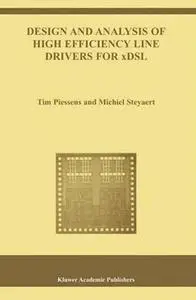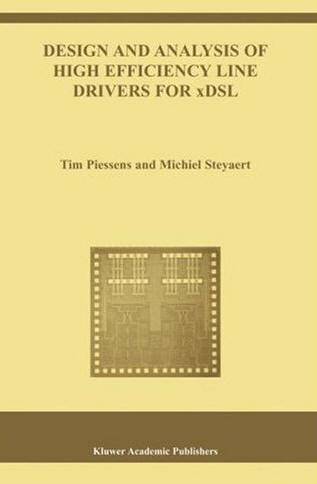Design and Analysis of High Efficiency Line Drivers for xDSL (The International Series in Engineering and Computer Science) by Tim Piessens, Michiel Steyaert
Publisher: Springer; 1 edition (March 31, 2004) | ISBN-10: 1402077270 | PDF | 3,8 Mb | 235 pages
Publisher: Springer; 1 edition (March 31, 2004) | ISBN-10: 1402077270 | PDF | 3,8 Mb | 235 pages
Design and Analysis of High Efficiency Line Drivers for xDSL covers the most important building block of an xDSL (ADSL, VDSL, …) system: the line driver. Traditional Class AB line drivers consume more than 70% of the total power budget of state-of-the-art ADSL modems. This book describes the main difficulties in designing line drivers for xDSL. The most important specifications are elaborated staring from the main properties of the channel and the signal properties. The traditional (class AB), state-of-the-art (class G) and future technologies (class K) are discussed. The main part of Design and Analysis of High Efficiency Line Drivers for xDSL describes the design of a novel architecture: the Self-Oscillating Power Amplifier or SOPA. This architecture uses a non-linear, asynchronous modulation scheme that enables highly efficient, highly linear transmission. The concept has been proven by two implementations in a digital CMOS technology: a G-Lite compliant line driver with 61% efficiency and a full ADSL-VDSL downstream compliant power amplifier with 47% power efficiency. The proposed architecture is fully analysed and complete design plans including CMOS scaling laws and software tools to facilitate the design of these types of amplifiers are extensively described. Since the analysis of a SOPA amplifier involves advanced non-linear system design techniques, Design and Analysis of High Efficiency Line Drivers for xDSL presents extensively advanced non-linear analysis techniques which not only aid the design of high efficiency line drivers but are also applicable in other domains of analog system design. Therefore Design and Analysis of High Efficiency Line Drivers for xDSL can be read not only as an exhaustive tutorial on the basic properties and limitations of an xDSL line driver, but also as a tutorial on advanced non-linear system design and a design manual of a highly efficient switching power amplifier.



